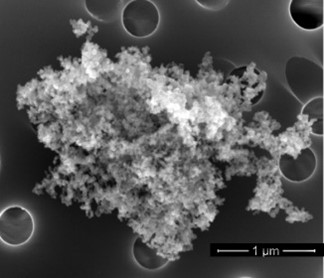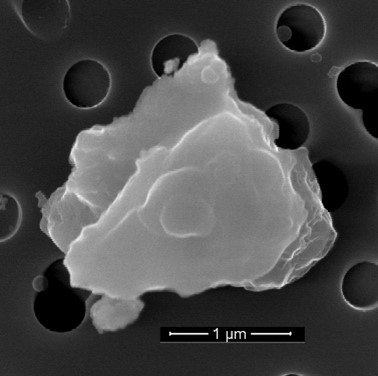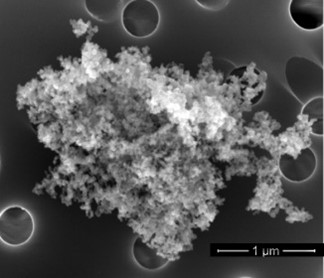Nanotechnologies is the 21st century hot topic and the industry is now manipulating and using materials at a nano scale, the size of molecules. Hence, these new structures are so small that the emission of respirable nanoparticles becomes a health concern. Despite toxicologists have not yet acted on the real impact on the human’s health and on the environment, a study from Current Biology[1] has revealed health-effect similarities between long-fibre carbon nano-tubes and asbestos-induced mesothelioma in humans.
But what is a nanoform? How do you define it?
In January 2020, European regulation REACH[2] has characterised a nano-form as “a form of a natural or manufactured substance containing particles, in an unbound state or as an aggregate or as an agglomerate and where, for 50 % or more of the particles in the number size distribution, one or more external dimensions is in the size range 1 nm-100 nm”.

Agglomerate 
Isolated Nanoparticles
In terms of comparisons:

If the Earth was 1 meter… 
A cherry would be 1 nanometer
Is there any regulation?
Considering that it’s a new matter, no regulation is definitely set neither exposition limits for nano compounds, except for Titanium Dioxide TiO2[3]: NIOSH recommends airborne exposure limits of 2.4 mg/m3 for fine TiO2 and 0.3 mg/m3 for ultrafine (including engineered nano-scale) TiO2, as time-weighted average (TWA) concentrations for up to 10 hours per day during a 40-hour work week.
What are the main industries concerned?
| Nano-materials manufacturing | Chemical industry |
| Metal machining / welding | 3D printing |
| Paint, Ink, Varnish | Photocatalysis / filtration |
| Plastics | Battery manufacturing |
| Research Laboratory | Cosmetics |
| Tire manufacturing | Construction, public works |
| Food | Pharmaceutical |
| Incineration | Public transport |
Risk management plan?
The ISO 12901-2[4] explains how to manage the occupational risk applied to engineered nano-materials in a standard reviewed in 2017.
In Australia, SafeWork[5] recommends to use the model in the Code of Practice: How to manage work health and safety risks as well as the Code of Practice: Managing risks of hazardous chemicals in the workplace to be applied to work safely with engineered nano-materials.
The AFNOR (French national organization for standardization) has published in June 2020 a new standard XP T16-402[6] dealing with the “Conduct of inhalation risk management of nano-objects and their aggregates and agglomerates (NOAA) and nano-particulate substances, for the proximity occupational hygienists”.
How do you deal with nanoparticles exposition?
As no fixed regulation is set yet, it is the employer’s will to check if the employees are working under a nanoparticle environment. That implies to do targeted air measurements depending on the activity and on the process of dealing with nanomaterials.
Two ways of analysing nano-particles regarding the standard BS EN 16966:2018[7] “Measurement of exposure by inhalation of nano-objects and their aggregates and agglomerates”:
- Direct measure: real-time sensor in mass, number and surface (cannot make the difference between agglomerates and non-nano plates; the results are not easy to exploit).
- Undirect measure: sampling of the respirable fraction (less than 10microns) then, laboratory analysing to distinguish the nanofrom the non-nano).

Non Nano
Three steps in the methodology following the standard BS EN 17058:2018[8] “Assessment of exposure by inhalation of nano-objects and their aggregates and agglomerates”:
- Initial evaluation (presence or not of nanoparticles by measuring on a fix point),
- Basic evaluation of the exposition (to know if the operator is exposed),
- Complete evaluation of the exposition (daily individual measure and quantification of what the operator is really breathing at the end of the day).
Then, depending on the results, the employer has the choice to put in place tailored solutions advised by the consultant to prevent this exposure and keep the employees in a safe workplace.
Checkout our in-house service for nanoparticles at: https://www.particlever-alcen.com/en
[1] https://www.cell.com/current-biology/pdfExtended/S0960-9822(17)31171-5
[2] https://ec.europa.eu/environment/chemicals/nanotech/reach-clp/index_en.htm
[3] https://www.cdc.gov/niosh/docs/2011-160/pdfs/2011-160.pdf
[4] https://www.iso.org/standard/53375.html
[5] https://www.safeworkaustralia.gov.au/system/files/documents/1702/safety-hazards-engineered-nanomaterials.pdf
[6] https://www.boutique.afnor.org/standard/xp-t16-402/nanotechnologies-conduct-of-inhalation-risk-management-of-nano-objects-and-their-aggregates-and-agglomerates-noaa-and-nanopa/article/944344/fa192162
[7] https://shop.bsigroup.com/ProductDetail?pid=000000000030323505
[8] https://shop.bsigroup.com/ProductDetail?pid=000000000030337090

